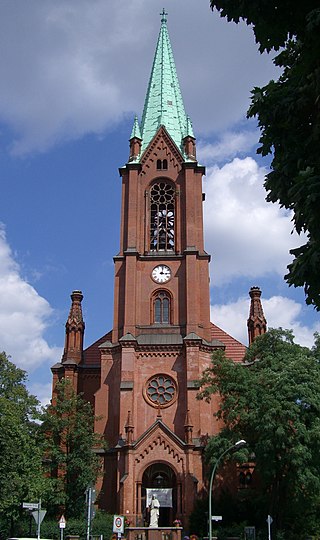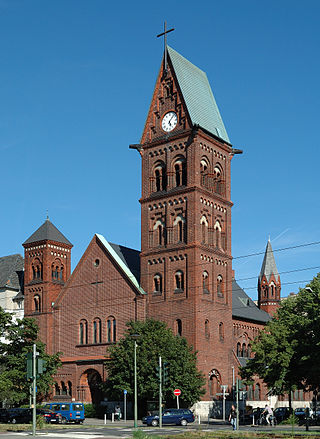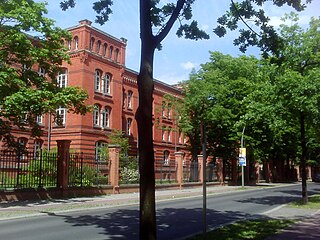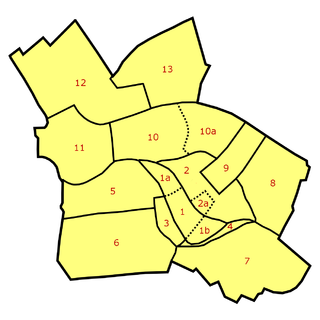Mischling was a pejorative legal term which was used in Nazi Germany to denote persons of mixed "Aryan" and non-Aryan, such as Jewish, ancestry as they were classified by the Nuremberg racial laws of 1935. In German, the word has the general denotation of hybrid, mongrel, or half-breed. Outside its use in official Nazi terminology, the term Mischlingskinder was later used to refer to war babies born to non-white soldiers and German mothers in the aftermath of World War II.

The Prussian Union of Churches was a major Protestant church body which emerged in 1817 from a series of decrees by Frederick William III of Prussia that united both Lutheran and Reformed denominations in Prussia. Although not the first of its kind, the Prussian Union was the first to occur in a major German state.

Oranienburger Straße is a street in central Berlin. It is located in the borough of Mitte, north of the River Spree, and runs south-east from Friedrichstraße to Hackescher Markt.

Westend is a locality of the Berlin borough Charlottenburg-Wilmersdorf in Germany. It emerged in the course of Berlin's 2001 administrative reform on the grounds of the former Charlottenburg borough. Originally a mansion colony, it is today a quite densely settled, still affluent territory adjacent to Berlin's inner city in the east.

Friedrich Karl Otto Dibelius was a German bishop of the Evangelical Church in Berlin-Brandenburg, a self-described anti-Semite and up to 1934 a conservative, who became a staunch opponent of Nazism and communism.

Monbijou Park is a park in Mitte, a district of Berlin, Germany. The park is bounded to the south by the river Spree, to the west by Monbijoustraße, and to the north Oranienburger Straße and Monbijouplatz. It is close to the Friedrichstadt Palast, Neue Synagogue and the Sophienkirche.

Monbijou Palace was a Rococo palace in central Berlin located in the present-day Monbijou Park on the north bank of the Spree river across from today's Bode Museum and within sight of the Hohenzollern city palace. Heavily damaged in World War II, the ruins were finally razed by the authorities of East Berlin in 1959. The palace has not been rebuilt.
The Pfarrernotbund was an organisation founded on 21 September 1933 to unite German evangelical theologians, pastors and church office-holders against the introduction of the Aryan paragraph into the 28 Protestant regional church bodies and the Deutsche Evangelische Kirche (DEK) and against the efforts by Reich-bishop Ludwig Müller and the German Christians (DC) since April 1933 to merge the German Protestant churches into one Reich Church that would be Nazi in ideology and entirely lacking any Jewish or Christian origins. As a Christian resistance to National Socialism it was the forerunner of the Confessing Church, founded the following year.

Jerusalem Church is one of the churches of the Evangelical Congregation in the Friedrichstadt, a member of the Protestant umbrella organisation Evangelical Church of Berlin-Brandenburg-Silesian Upper Lusatia. The present church building is located in Berlin, borough Friedrichshain-Kreuzberg, in the quarter of Friedrichstadt. Jerusalem Church is fourth in rank of the oldest oratories in the town proper.

Gethsemane Church is one of four church buildings of the Lutheran Northern Prenzlauer Berg Evangelical Congregation, within the Evangelical Church of Berlin-Brandenburg-Silesian Upper Lusatia, an umbrella organisation which includes Lutheran, Reformed, and United Protestant Calvinist congregations.

Capernaum Church is one of the two places of worship of the Lutheran Capernaum Congregation, a member of the Evangelical Church of Berlin-Brandenburg-Silesian Upper Lusatia, an umbrella comprising Lutheran, Calvinist (Reformed) and united Protestant congregations. The church is located on Seestraße No. 34 in the locality of Wedding, in Berlin's borough of Mitte. The church was named after Capernaum, today Kfar Nachum כפר נחום in today's Israel.

Mitte is a central section of Berlin, Germany, in the eponymous borough of Mitte. Until 2001, it was itself an autonomous district.

Jesus Church (Kaulsdorf) (German: Jesuskirche, colloquially also Dorfkirche, village church) is the church of the Evangelical Berlin-Kaulsdorf Congregation, a member of today's Protestant umbrella organisation Evangelical Church of Berlin-Brandenburg-Silesian Upper Lusatia (under this name since 2004). The church building is located in Berlin, borough Marzahn-Hellersdorf, in the locality of Kaulsdorf. The church was named after Jesus of Nazareth. The congregation's parish comprises the area of the historical village of Kaulsdorf, which had been incorporated into Berlin by the Prussian Greater Berlin Act in 1920.
The Reich Association of Jews in Germany, also called the new one for clear differentiation, was a Jewish umbrella organisation formed in Nazi Germany in February 1939. The Association branched out from the Reich Representation of German Jews established in September 1933. The new Association was an administrative body concerned predominantly with the coordination and support of the emigration and forcible deportation of Jewish people, subject to the Reich government's ever-changing legislation enforced by the RSHA (Reichssicherheitshauptamt). The legal status of the new organisation was changed on 4 July 1939 on the basis of the Nuremberg Laws, and defined by the 10th Regulation to the Citizenship Law issued by the Reich's ministry of the Interior. The Association assumed the so-called oldReichsvereinigung der Juden in Deutschland, which was the name under which the Reichsvertretung der Deutschen Juden had been operating since February 1939.

Christ Church, Jerusalem, is an Anglican church located inside the Old City of Jerusalem, established in 1849 by the London Society for Promoting Christianity Amongst the Jews. It was the original seat of the Anglican Bishop in Jerusalem until the opening of St. George's Cathedral, Jerusalem in 1899; the compound also included the 19th century British Consulate. From its inception, Christ Church has been supporting a form of Christianity focused on Jesus' Jewishness, offering Christian texts translated into Hebrew by its own leaders.

The Wilhelmstraße in the Berliner district of Spandau is the connecting street between Spandau and Potsdam. In the north, at Seeburger Straße and the Ziegelhof, the Wilhelmstraße runs into the Klosterstraße, about a kilometre south of Spandau Station.
More than 60 percent of Berlin residents have no registered religious affiliation. As of 2010, at least 30 percent of the population identified with some form of Christianity, approximately 8.1 percent were Muslim, 1 percent were Jewish, and 1 percent belonged to other religions. As of 2018, the number of registered church members has shrunk to 14.9 percent for EKD Protestants and 8.5 percent for Catholics.

The Deutsche Evangelische Christuskirche is a church on Montpelier Place in Knightsbridge, London. German Christian theologian Julius Rieger has described it as the most significant German church in London.

Heinrich Grüber was a Reformed theologian, pacifist and opponent of Nazism.

Spandauer Vorstadt is a historic district in what is now the Mitte district of Berlin.



















